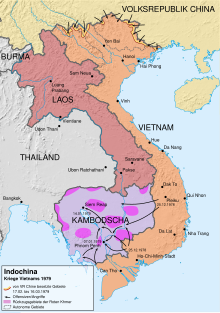
Back حرب الهند الصينية الثالثة Arabic Guerra de Indochina (1975-1991) Spanish Terza guerra d'Indocina Italian 第三次インドシナ戦争 Japanese ინდოჩინეთის მესამე ომი Georgian សង្គ្រាមឥណ្ឌូចិនលើកទី៣ Cambodian 제3차 인도차이나 전쟁 Korean ສົງຄາມອິນດູຈີນຄັ້ງທີສາມ Laothian Terceira Guerra da Indochina Portuguese Treći indokineski rat Serbo-Croatian
| Third Indochina War | ||||||||
|---|---|---|---|---|---|---|---|---|
| Part of the Indochina Wars, the Cold War, and the Sino-Soviet split | ||||||||
 | ||||||||
| ||||||||
| Belligerents | ||||||||
|
|
|
Supported by: | ||||||
| Commanders and leaders | ||||||||
| Unknown | |||||||
| Strength | ||||||||
| ~800,000 military | ~430,000 military | Unknown | ||||||
| Casualties and losses | ||||||||
| ~310,000 military deaths |
Vietnam: 105,627 military deaths[2] | Unknown | ||||||
The Third Indochina War was a series of interconnected armed conflicts, mainly among the various communist factions over strategic influence in Indochina after Communist victory in South Vietnam, Laos, and Cambodia in 1975.[3][4] The conflict primarily started due to continued raids and incursions by the Khmer Rouge into Vietnamese territory that they sought to retake. These incursions would result in the Cambodian–Vietnamese War in which the newly unified Vietnam overthrew the Pol Pot regime and the Khmer Rouge, in turn ending the Cambodian genocide. Vietnam had installed a government led by many opponents of Pol Pot, most notably Hun Sen, a former Khmer Rouge commander. This led to Vietnam's occupation of Cambodia for over a decade. The Vietnamese push to completely destroy the Khmer Rouge led to them conducting border raids in Thailand against those who had provided sanctuary.[5][6]
China strongly objected to the invasion of Cambodia. Chinese armed forces launched a punitive operation (Sino-Vietnamese War) in February 1979 and attacked Vietnam's northern provinces, determined to contain Soviet/Vietnamese influence and prevent territorial gains in the region.[7][8]
In order to acquire full control over Cambodia the People's Army of Vietnam needed to dislodge the remaining Khmer Rouge leaders and units, which had retreated to the remote areas along the Thai-Cambodian border.[9] After the Paris Peace Conference in 1989, the PAVN withdrew from Cambodian territory. Finally regular troop engagements in the region ended after the conclusion of the 1991 Paris Peace Accords.[10][11]
In Laos, an insurgency is still ongoing, though to a lesser extent since 2007, with the government being supported by both China and Vietnam.
- ^ "Outside Interference in Vietnamese Affairs Condemned" (PDF). www.cambodiatokampuchea.wordpress.com. July 20, 1978.
- ^ Chuyên đề 4 CÔNG TÁC TÌM KIẾM, QUY TẬP HÀI CỐT LIỆT SĨ TỪ NAY ĐẾN NĂM 2020 VÀ NHỮNG NĂM TIẾP THEO, datafile.chinhsachquandoi.gov.vn/Quản%20lý%20chỉ%20đạo/Chuyên%20đề%204.doc
- ^ Cite error: The named reference
:0was invoked but never defined (see the help page). - ^ Ang, Cheng Guan (2024). The Third Indochina War: An International History. Cambridge University Press. ISBN 978-1-009-56007-8.
- ^ Kelvin Rowley. "Second Life, Second Death: The Khmer Rouge After 1978" (PDF). Swinburne University of Technology. Archived from the original (PDF) on February 16, 2016. Retrieved March 11, 2018.
- ^ "1978-1979 - Vietnamese Invasion of Cambodia". GlobalSecurity. Retrieved March 11, 2018.
- ^ Bernard K. Gordon (September 1986). "The Third Indochina Conflict". Foreign Affairs. 65 (Fall 1986). Retrieved March 11, 2018.
- ^ "The 1979 campaign" (PDF). All Partners Access Network. Archived from the original (PDF) on July 6, 2020. Retrieved March 31, 2018.
- ^ "Viets shell Cambodian positions..." January 2, 1985. Retrieved March 11, 2018.
- ^ Lucy Keller. "UNTAC in Cambodia – from Occupation, Civil War and Genocide to Peace - The Paris Peace Conference in 1989" (PDF). Max-Planck-Institut für ausländisches öffentliches Recht und Völkerrecht. Retrieved March 31, 2018.
- ^ "Cambodia - 20 years on from the Paris Peace Agreements". OHCHR. October 21, 2011. Retrieved March 31, 2018.